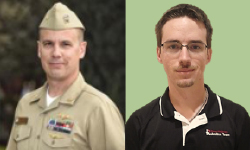April 1, 2016 - Energy Academic Group
 Extending the Navy's Global Reach by Optimizing Fuel Usage Tools: Optimized Transit Tool and Easy Reference (OTTER) and Fuel Usage Study Extended Demonstration (FUSED)
Extending the Navy's Global Reach by Optimizing Fuel Usage Tools: Optimized Transit Tool and Easy Reference (OTTER) and Fuel Usage Study Extended Demonstration (FUSED)
Aoril 1, 2016
IN122
1300
LCDR Korban Blackburn, SC, USN
Operations Research Graduate, Supply Corps, United States Navy
Mr. Brandon Naylor
Research Engineering / Scientist Associate III, UT Austin
Abstract
Fuel efficiency is a priority for the Chief of Naval Operations (CNO) as stated in the CNO’s Position Report: 2014. While a number of fuel-saving measures have been implemented in recent years, the effects of operational transit speed on fuel consumption have not been realized. A ship commanding officer can use fuel-usage curves to determine the most efficient propulsion plant speed. If the required speed is anything other than optimum, ships do not consider alternatives. There often exists however, combinations of speeds that are more fuel efficient than this constant speed. OTTER produces two intuitive tools that take advantage of these optimal speeds. First created is a dynamic, versatile and interactive planning tool for any ship class transit including drill scheduling. Second, the generic optimized solution to individual ship transit speed combinations displayed on a paper reference sheet that can be used independently. These products yield significant savings with no operational impact on the fleet.
Policies and practices for surface ship operation have been established to minimize the risk to which ships are exposed, but these often involve operating in a way that reduces overall fuel efficiency. Lowered fuel efficiency introduces its own risks: ships are very vulnerable while refueling, while the need to refuel frequently reduces operational capability. FUSED can be used to model the fuel usage of the surface fleet while operating under different policy sets. The user can then see how different policy changes affect how often a ship or group needs to refuel. With this information, the user can make an informed decision when comparing the benefit of a new policy or practice against the expected risk.
Biography
LCDR Korban Blackburn, SC, USN
LCDR Blackburn enlisted in the USN as a Nuclear trained Mechanic in 2000, graduating in the top 10% of his nuclear training class. He was selected to be a staff instructor at Nuclear Power Training Unit Charleston, where he served until 2005, attaining the rank of MM1. LCDR Blackburn was then selected to attend Officer Candidate School where he earned his commission.
LCDR Blackburn has served in various key leadership positions afloat. After graduating in the top 5% of his class in Athens, he served as Supply Officer on the USS NEVADA (SSBN 733) from 2006-2008. Serving as s a key watch stander on 3 strategic deterrent patrols, he took the boat into the shipyard for a successful Integrated Logistics Overhaul and Engineering Refueling Overhaul. Most recently, he served as Materials Division Officer, Aviation Stores Division Officer and Principal Assistant to Logistics in USS MAKIN ISLAND (LHD-8).
Ashore, he served as the Immediate Supervisor In Charge and Department Head at Naval Submarine Support Center Bangor, where he provided logistic support, technical expertise and financial oversight of four staff commands and 19 Ballistic Missile Submarine and Guided Missile Submarine crews.
His personal awards include the Navy and Marine Corps Commendation Medal (two stars), Navy and Marine Corps Achievement Medal and various personal and unit awards. He is qualified Submarine Supply Corps Officer, Surface Warfare Supply Corps Officer and Naval Aviation Supply Officer.
LCDR W. Korban Blackburn is a native of Hawaii and fluent in Danish. He earned his Associates in Arts from Brigham Young University, and subsequently a BA in Humanities and BSAST in Nuclear Engineering from Thomas Edison State College.
Mr. Brandon Naylor
Mr. Naylor began his association with the Energy Academic Group (EAG) as an NREIP intern in the summer of 2014. It was there that he created the original Fuel Usage Study Extended Demonstration (FUSED) model. At the end of the internship, Brandon continued working with the EAG as a part time contractor while still in school. The following summer he led a team of SEAP and NREIP interns to complete two projects that improved FUSED, and then used it to model the effects that different practices have on surface fleet fuel consumption and time on station. At the same time he began working with LCDR Blackburn to develop the Optimized Transit Tool Easy Reference (OTTER). Brandon and LCDR Blackburn presented FUSED and OTTER at the Athena 8 Naval Innovation Conference in August 2015 where they won the Admiral Sims Award for Intellectual Courage. Brandon is currently employed by the University of Texas at Austin but operates out of the Naval Postgraduate School where he continues his work with the EAG. Brandon holds a BS in Mechanical Engineering with a minor in Robotics from Rose-Hulman Institute of Technology.
POC
Dr. Daniel A. Nussbaum
Naval Postgraduate School
Principal, Energy Academic Group
Monterey CA 93943
Phone: 831-656-2387
Mobile: 831-324-3228
Email: dnussbaum@nps.edu

